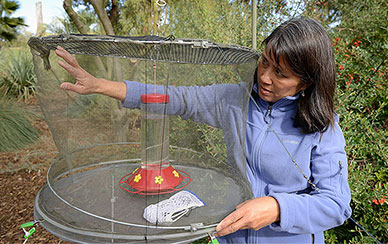Hummingbirds Reveal Evidence of Insecticide Exposure 
Lisa Tell is an avian veterinarian at the UC Davis School of Veterinary Medicine and Director of the Hummingbird Health and Conservation Program.
With support from WHP, University of California at Davis researcher Lisa Tell and her colleagues developed a method to detect the presence of pesticides in hummingbirds. They then used their technique to test for as many 150 drugs, pesticides, and other products in Black-chinned and Anna's Hummingbirds in California.
The results of their work demonstrate that over 68% of their specimens were exposed to insecticides and that the chemicals were found mostly on feathers, rather than in internal organs. This result raises the question about whether or not hummingbirds ingest insecticides or are exposed to them in other ways. The use of synthetic chemicals has increased rapidly, despite Rachel Carson's cautionary words in Silent Spring. Dr. Tell hopes that her work will contribute to our understanding of how chemicals impact birds, especially small species such as hummingbirds, and to their conservation.
|